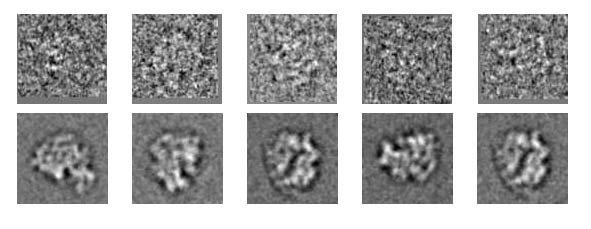Class averaging is a crucial initial step in SPR, because the SNR of raw projection images is typically too low for reconstruction. Class averaging amplifies the SNR by averaging noisy images of similar view angles. The averaged de-noised images form the input to ab-initio reconstruction and refinement algorithms. Improved class averaging algorithms are thus of great importance as they will allow reconstructions at lower SNRs.
Our class averaging procedure is fast (nearly linear running time in the number of images) and succeeds at remarkably low levels of signal-to-noise ratio. Here are the steps of the procedure:
1) Steerable PCA and Wiener filtering for image de-noising
2) Rotational invariant representation of images using bispectrum
3) Fast randomized singular value decomposition (SVD) for dimensionality reduction of the bispectrum
4) Nearest neighbors search in the reduced rotationally invariant feature space (no 2D alignment of images is required). For very large datasets, the randomized approximate nearest neighbors algorithm can be used for speedup of the search.
5) 2D alignment of neighboring images
6) Vector diffusion map for computing new distances between images and improve the initial classification.
Our class averaging procedure is an alternative to the MSA classification algorithm and the reference-free alignment procedure that are widely used in the field.
Further reading:
Z. Zhao, A. Singer, Rotationally Invariant Image Representation for Viewing Direction Classification in Cryo-EM, Journal of Structural Biology, 186 (1), pp. 153-166 (2014).
A. Singer, H.-T. Wu, Vector Diffusion Maps and the Connection Laplacian, Communications on Pure and Applied Mathematics (CPAM), 65 (8), pp. 1067-1144 (2012). PMID: 24415793 [PubMed] PMCID: PMC3886882.
A. Singer, Z. Zhao, Y. Shkolnisky, R. Hadani, Viewing Angle Classification of Cryo-Electron Microscopy Images using Eigenvectors, SIAM Journal on Imaging Sciences, 4 (2), pp. 543-572 (2011). PMID: 22506089 [PubMed] PMCID: PMC3325115.
R. Hadani, A. Singer, Representation theoretic patterns in three dimensional Cryo-Electron Microscopy II - The class averaging problem, Foundations of Computational Mathematics (FoCM), 11 (5), pp. 589-616 (2011). PMID: 23239955 [PubMed] PMCID: PMC3519397.
